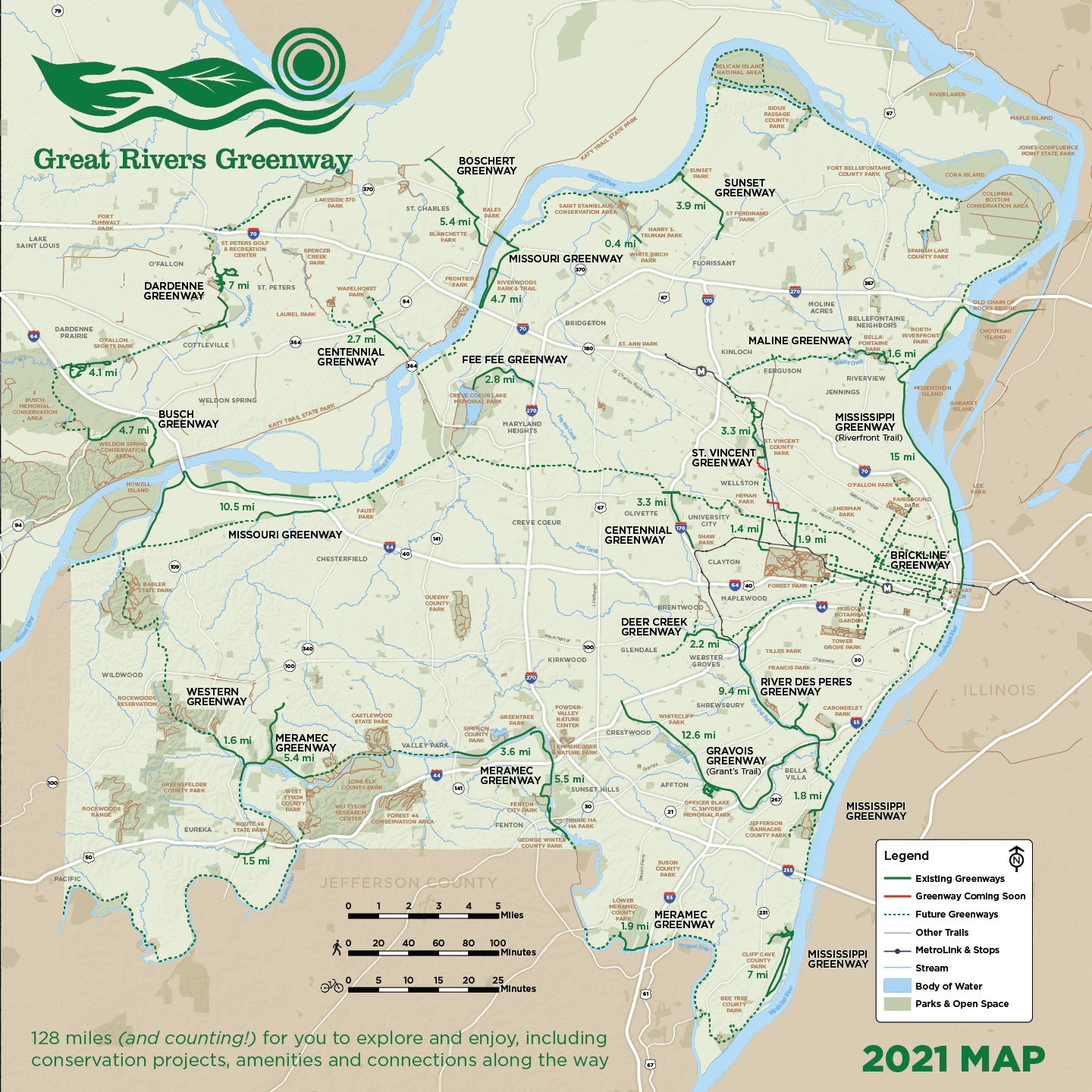What is the Mississippi Greenway?
 The master plan for the Mississippi Greenway stretches 32 miles from the Missouri River at Pelican Island Natural Area to the Meramec Greenway near Bee Tree Park in south St. Louis County. When complete, it will connect with the Missouri Greenway, Maline Greenway, the Trestle, the Arch grounds, Gateway Mall and River des Peres and Meramec Greenways south of downtown St. Louis.
The master plan for the Mississippi Greenway stretches 32 miles from the Missouri River at Pelican Island Natural Area to the Meramec Greenway near Bee Tree Park in south St. Louis County. When complete, it will connect with the Missouri Greenway, Maline Greenway, the Trestle, the Arch grounds, Gateway Mall and River des Peres and Meramec Greenways south of downtown St. Louis.
Projects within the greenway include Jones-Confluence Point State Park in St. Charles County, the Old Chain of Rocks Bridge and Riverfront Trail in the City of St. Louis, the McKinley Bridge Bikeway and Branch Street Trestle and the Trestle in the City of St. Louis.
Current Status
North-Downtown St. Louis Riverfront to Old Chain of Rocks Bridge
The 12.5 mile Mississippi Greenway: Chouteau Riverfront to Old Chain of Rocks Bridge (Riverfront Trail) winds through both sides of the flood wall that protects the City of St. Louis and offers views of the working riverfront that even most native St. Louisans have never seen before. A 1.5 mile extension from Biddle to Chouteau opened in June 2016 and now connects to the new circulation pathways on the Gateway Arch grounds.
South- Cliff Cave County Park and Jefferson Barracks to River des Peres
Currently, there are two completed greenways south of downtown St. Louis along the Mississippi Greenway–Cliff Cave County Park and Jefferson Barracks to River City Casino.
Mississippi Greenway: Jefferson Barracks to River City Casino extends 1.6 miles from the trailhead in Jefferson Barracks Park to the northern edge of the River City Casino Property along the River des Peres. Visitors to Jefferson Barracks Park in St. Louis County can use this greenway to get an up close view of the Mississippi River, and will soon be able to walk or ride all the way to Carondelet Park or the Lansdowne-Shrewsbury MetroLink Station via the River des Peres Greenway.
Mississippi Greenway: Cliff Cave County Park is a 4.7 mile loop (paved) nestled in a unique park that gets its name from the cave tucked in the bluffs of south St. Louis County. The park offers hiking, mountain biking, and equestrian trails as well as picnic areas and shelters. Construction on a new overlook, two bridges and a paved, ADA accessible greenway that will connect the upper and lower sections of the park along with a neighborhood spur out to Telegraph Road is underway. Click here to see videos of the bridge installations. (Fun fact: the new bridge over Cliff Cave Road is largest single span pedestrian bridge in the region!)
Exploring the Mississippi Greenway
There is so much to see along this greenway from iconic landmarks to industrial operations, to sweeping views of the Mississippi River!
Old Chain of Rocks Bridge:
 For more than three decades this bridge was a landmark for travelers along Route 66. It is now open daily for people to walk or ride bikes to connect to Illinois or simply enjoy views of the Mississippi River! The bridge has appeared in movies such as “Escape from New York” in 1980 and most recently for “The Empty Man” slated to be released sometime in 2018. In February 2018, the bridge will be closed to all visitors for approximately one month to complete some necessary repairs to the bridge deck.
For more than three decades this bridge was a landmark for travelers along Route 66. It is now open daily for people to walk or ride bikes to connect to Illinois or simply enjoy views of the Mississippi River! The bridge has appeared in movies such as “Escape from New York” in 1980 and most recently for “The Empty Man” slated to be released sometime in 2018. In February 2018, the bridge will be closed to all visitors for approximately one month to complete some necessary repairs to the bridge deck.
Mark your calendars to join us January 13 and 14, 2018 for Eagle Days at the Old Chain of Rocks Bridge—a two day festival celebrating our nation’s emblem bird.
NOTE: There is no parking on the Missouri side of the bridge, but you can park on the Illinois side –Click here for directions. Of course, you can also ride your bike from downtown St. Louis near the Arch grounds!
Cliff Cave Park:
While construction is underway in the upper section of the park, bring your bike or enjoy a walk on the Mississippi Trail. This 4.6-mile paved, loop asphalt trail circles the floodplain bottomland and offers beautiful views of the river and fall colors on the bluffs. Plan your visit here.
Projects and Partnerships along the Mississippi Greenway
Greenway Guides
 For the past three years, Great Rivers Greenway has partnered with the Urban League of St. Louis for the Greenway Guide Program. After completing training with the Urban League, Guides work together with staff, other support teams and partners at the City of St. Louis to monitor and patrol this greenway. Guides also operate the Mary Meachum Visitor’s Center—Friday through Sunday—offering support such as bicycle repair, directions and first aid. Not only does the partnership provide excellent job training and employment for our community through the Save Our Sons program, it also enhances the experience for people using the Mississippi Greenway from the Old Chain of Rocks Bridge to Leonor K. Sullivan Blvd at Chouteau. Since its inception in 2015, 18 individuals have leveraged their experience as a Greenway Guide into full-time jobs.
For the past three years, Great Rivers Greenway has partnered with the Urban League of St. Louis for the Greenway Guide Program. After completing training with the Urban League, Guides work together with staff, other support teams and partners at the City of St. Louis to monitor and patrol this greenway. Guides also operate the Mary Meachum Visitor’s Center—Friday through Sunday—offering support such as bicycle repair, directions and first aid. Not only does the partnership provide excellent job training and employment for our community through the Save Our Sons program, it also enhances the experience for people using the Mississippi Greenway from the Old Chain of Rocks Bridge to Leonor K. Sullivan Blvd at Chouteau. Since its inception in 2015, 18 individuals have leveraged their experience as a Greenway Guide into full-time jobs.
On-the-Job Horticulture Training with St. Patrick Center
Great Rivers Greenway has teamed up with the St. Patrick Center to provide hands-on maintenance, landscape and horticulture training along the Mississippi Greenway. St. Patrick Center clients work side-by-side with Great Rivers Greenway staff and other partners to maintain three pollinator gardens at the McKinley Bridge Bikeway, Mary Meachum Center and Old Chain of Rocks Bridge. They also assist as needed with weeding, mulching, pruning, and invasive species removal.
Not only does this provide valuable on-the-job landscaping and trade skills for the St. Patrick Center clients, it also helps restore habitat, better maintain the greenway, and enhance the visitor experience for everyone. Watch a video about the program here.
Pollinator Partnership with St. Louis University
 Great Rivers Greenway has partnered with St. Louis University to host two internships on pollinator diversity in urban environments. These positions support research efforts currently underway by St. Louis University Associate Professor of Biology Dr. Gerardo Camillo. To date, he has documented 169 species of bees in St. Louis –the highest bee diversity of any city in North America. The science-based data collected will be used to guide the District’s efforts of creating pollinator habitat to increase biodiversity. You can watch the video of an interview with Dr. Camillo and the interns here.
Great Rivers Greenway has partnered with St. Louis University to host two internships on pollinator diversity in urban environments. These positions support research efforts currently underway by St. Louis University Associate Professor of Biology Dr. Gerardo Camillo. To date, he has documented 169 species of bees in St. Louis –the highest bee diversity of any city in North America. The science-based data collected will be used to guide the District’s efforts of creating pollinator habitat to increase biodiversity. You can watch the video of an interview with Dr. Camillo and the interns here.
